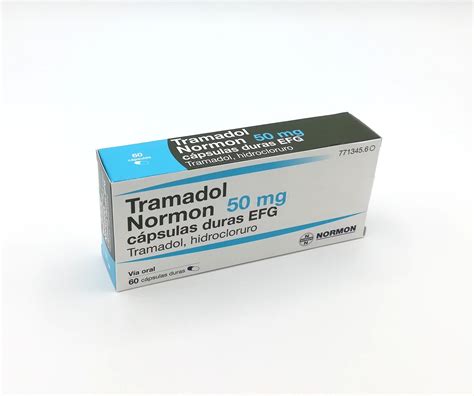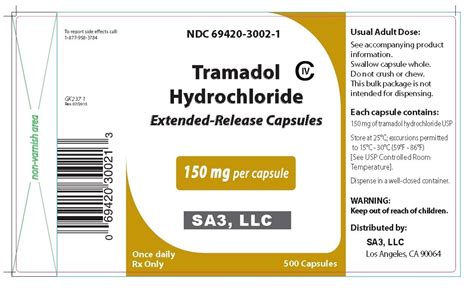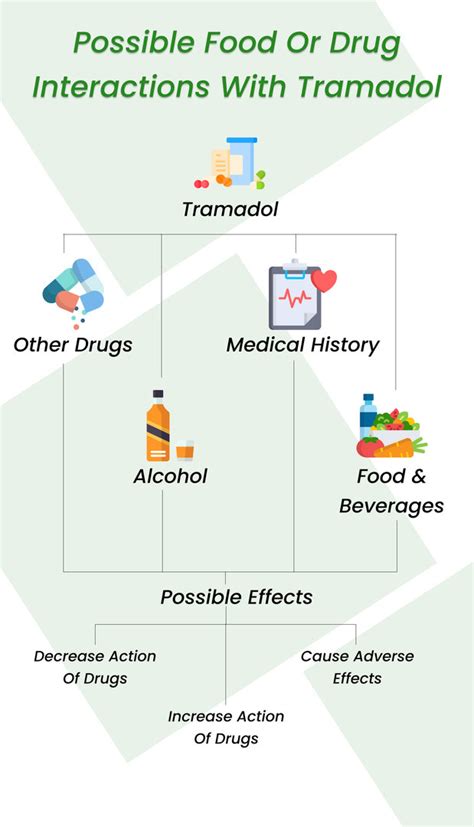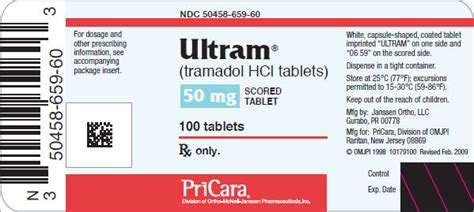Intro
Discover the uses and effects of 50 Mg Tramadol, a potent pain reliever, and learn about dosage, interactions, and side effects, including opioid addiction risks and withdrawal symptoms, for safe management of moderate to severe pain.
Tramadol is a prescription medication used to treat moderate to moderately severe pain. It is a synthetic opioid analgesic that works by binding to opioid receptors in the brain, spinal cord, and other areas, altering the body's perception of and response to pain. The 50 mg tramadol dosage is a common strength for this medication, and it is available in various forms, including tablets, capsules, and oral solutions.
Tramadol is often prescribed for patients who have not found relief from other pain medications or who have certain medical conditions that make it difficult to take other types of pain relievers. It is essential to use tramadol only as directed by a healthcare provider, as misuse or abuse can lead to serious side effects, including addiction, overdose, and death. Patients should carefully follow the prescribed dosage and frequency of use to minimize the risk of adverse effects.
The effects of tramadol can vary depending on the individual and the specific condition being treated. In general, tramadol starts to work within 30 minutes to 1 hour after taking a dose, and its pain-relieving effects can last for several hours. Patients may experience side effects such as dizziness, drowsiness, nausea, vomiting, constipation, and headache while taking tramadol. These side effects are usually mild to moderate and may subside as the body adjusts to the medication.
How Tramadol Works

Tramadol works by interacting with opioid receptors in the brain, spinal cord, and other areas. It binds to these receptors, altering the body's perception of and response to pain. Tramadol also inhibits the reuptake of serotonin and norepinephrine, two neurotransmitters involved in pain transmission. This dual mechanism of action allows tramadol to provide effective pain relief for a wide range of conditions, including chronic pain, neuropathic pain, and pain associated with surgery or injury.
Benefits of Tramadol
The benefits of tramadol include its ability to provide effective pain relief for patients who have not responded to other medications. Tramadol is also relatively well-tolerated, with most patients experiencing only mild to moderate side effects. Additionally, tramadol has a lower risk of addiction and dependence compared to other opioid medications, making it a safer option for long-term use.Common Uses of Tramadol

Tramadol is commonly used to treat a variety of pain conditions, including:
- Chronic pain: Tramadol is often prescribed for patients with chronic pain who have not found relief from other medications.
- Neuropathic pain: Tramadol can help alleviate pain associated with nerve damage, such as diabetic neuropathy or postherpetic neuralgia.
- Postoperative pain: Tramadol may be used to manage pain following surgery or medical procedures.
- Cancer pain: Tramadol can be used to treat pain associated with cancer or cancer treatment.
- Fibromyalgia: Tramadol may be prescribed for patients with fibromyalgia, a chronic condition characterized by widespread muscle pain and fatigue.
Risks and Side Effects of Tramadol
While tramadol is generally considered safe and effective, it can cause side effects and interact with other medications. Common side effects of tramadol include: * Dizziness or lightheadedness * Drowsiness or fatigue * Nausea or vomiting * Constipation * Headache * Dry mouth * SweatingMore serious side effects can occur, such as:
- Allergic reactions
- Seizures
- Serotonin syndrome
- Adrenal insufficiency
- Androgen deficiency
Interactions with Other Medications

Tramadol can interact with other medications, including:
- Other opioid medications: Taking tramadol with other opioid medications can increase the risk of adverse effects, including addiction, overdose, and death.
- Benzodiazepines: Combining tramadol with benzodiazepines can increase the risk of respiratory depression, sedation, and other adverse effects.
- Antidepressants: Tramadol can interact with certain antidepressants, such as selective serotonin reuptake inhibitors (SSRIs), and increase the risk of serotonin syndrome.
- Muscle relaxants: Taking tramadol with muscle relaxants can increase the risk of sedation, respiratory depression, and other adverse effects.
Precautions and Warnings
Patients taking tramadol should be aware of the following precautions and warnings: * Tramadol can cause dizziness or drowsiness, so patients should avoid driving or operating heavy machinery until they know how the medication affects them. * Tramadol can increase the risk of falls, so patients should use caution when standing or walking. * Tramadol can cause constipation, so patients should increase their fiber intake and stay hydrated to minimize this risk. * Tramadol can interact with other medications, so patients should inform their healthcare provider about all medications they are taking.Dosage and Administration

The dosage and administration of tramadol vary depending on the individual and the specific condition being treated. The typical dosage range for tramadol is 50-100 mg every 4-6 hours as needed, not to exceed 400 mg per day. Patients should follow the prescribed dosage and frequency of use to minimize the risk of adverse effects.
Overdose and Dependence
Tramadol can cause overdose and dependence, especially when taken in high doses or for extended periods. Patients should be aware of the signs of overdose, which can include: * Slow or shallow breathing * Confusion or loss of consciousness * Seizures * ComaIf a patient experiences any of these symptoms, they should seek medical attention immediately.
Alternatives to Tramadol

For patients who are unable to take tramadol or who experience adverse effects, there are alternative pain medications available. Some alternatives to tramadol include:
- Acetaminophen: A mild pain reliever that can be used to treat headaches, fever, and minor aches and pains.
- Ibuprofen: A nonsteroidal anti-inflammatory drug (NSAID) that can be used to treat pain, inflammation, and fever.
- Naproxen: An NSAID that can be used to treat pain, inflammation, and fever.
- Gabapentin: An anticonvulsant medication that can be used to treat neuropathic pain, seizures, and anxiety.
- Pregabalin: An anticonvulsant medication that can be used to treat neuropathic pain, seizures, and anxiety.
Conclusion and Next Steps
In conclusion, tramadol is a prescription medication that can provide effective pain relief for a wide range of conditions. While it is generally considered safe and well-tolerated, it can cause side effects and interact with other medications. Patients should carefully follow the prescribed dosage and frequency of use to minimize the risk of adverse effects. For patients who are unable to take tramadol or who experience adverse effects, there are alternative pain medications available.We invite you to share your thoughts and experiences with tramadol in the comments below. If you have any questions or concerns about tramadol or other pain medications, please do not hesitate to reach out to your healthcare provider.
What is tramadol used for?
+Tramadol is a prescription medication used to treat moderate to moderately severe pain. It is commonly used to treat chronic pain, neuropathic pain, postoperative pain, cancer pain, and fibromyalgia.
How does tramadol work?
+Tramadol works by interacting with opioid receptors in the brain, spinal cord, and other areas. It binds to these receptors, altering the body's perception of and response to pain. Tramadol also inhibits the reuptake of serotonin and norepinephrine, two neurotransmitters involved in pain transmission.
What are the common side effects of tramadol?
+Common side effects of tramadol include dizziness or lightheadedness, drowsiness or fatigue, nausea or vomiting, constipation, headache, dry mouth, and sweating. More serious side effects can occur, such as allergic reactions, seizures, serotonin syndrome, adrenal insufficiency, and androgen deficiency.
